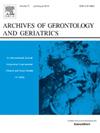Examination of the relationship between participation in salons aimed at care prevention through the promotion of social participation and the subsequent cost of care: A 3-year prospective follow-up study in JAGES
IF 3.5
3区 医学
Q2 GERIATRICS & GERONTOLOGY
引用次数: 0
Abstract
Many previous studies have found that social participation improves the health and functional maintenance of older people. However, to determine whether promoting social participation can prevent functional decline in the elderly, it is necessary not only to compare the prognosis of those who participate in social activities to those who do not but also to demonstrate that the intervention was effective in promoting social participation. Although the effect of social participation in preventing caregiving has been demonstrated, the key question is whether preventing functional decline through social participation can reduce care costs. This study aims to examine the relationship between participation in salons aimed at care prevention through the promotion of social participation and the subsequent cost of care. We use the Japan Gerontological Evaluation Study (JAGES) dataset to conduct longitudinal, individuallevel analysis. We focus on all residents 65 years and older who did not have a without disability in Taketoyo town and ran three regression analyses. First, a generalized linear model (GLM) with Tweedie distribution and log-link function, as well as robust estimation of variance components was used to estimate the dependent variables. Second, we used an inverse probability weighting (IPW) model to minimize selection bias. Finally, we performed the IV analysis. In this study, the GLM with IPW and IV models revealed link between salon participants and lower caregiving costs. The link between participation and caregiving costs was confirmed in a model with reduced selection bias, rather than in a simple GLM model.
研究参加旨在通过促进社会参与来预防护理的沙龙与后续护理成本之间的关系:JAGES 的一项为期 3 年的前瞻性跟踪研究。
以往的许多研究发现,社会参与能改善老年人的健康和功能维持。然而,要确定促进社会参与是否能预防老年人功能衰退,不仅需要比较参与社会活动者与不参与社会活动者的预后,还需要证明干预措施对促进社会参与是有效的。虽然社会参与在预防护理方面的效果已经得到证实,但关键问题是,通过社会参与预防功能衰退能否降低护理成本。本研究旨在探讨通过促进社会参与来预防护理的沙龙活动与后续护理成本之间的关系。我们使用日本老年学评估研究(JAGES)数据集进行纵向、个人层面的分析。我们以武丰町所有 65 岁及以上且无残疾的居民为研究对象,进行了三次回归分析。首先,我们使用了带有 Tweedie 分布和对数连接功能的广义线性模型(GLM)以及对方差成分的稳健估计来估计因变量。其次,我们使用了反概率加权(IPW)模型来减少选择偏差。最后,我们进行了 IV 分析。在本研究中,使用 IPW 和 IV 模型的 GLM 显示了沙龙参与者与较低护理成本之间的联系。在一个减少了选择偏差的模型中,而不是在一个简单的 GLM 模型中,参与与护理成本之间的联系得到了证实。
本文章由计算机程序翻译,如有差异,请以英文原文为准。
求助全文
约1分钟内获得全文
求助全文
来源期刊
CiteScore
7.30
自引率
5.00%
发文量
198
审稿时长
16 days
期刊介绍:
Archives of Gerontology and Geriatrics provides a medium for the publication of papers from the fields of experimental gerontology and clinical and social geriatrics. The principal aim of the journal is to facilitate the exchange of information between specialists in these three fields of gerontological research. Experimental papers dealing with the basic mechanisms of aging at molecular, cellular, tissue or organ levels will be published.
Clinical papers will be accepted if they provide sufficiently new information or are of fundamental importance for the knowledge of human aging. Purely descriptive clinical papers will be accepted only if the results permit further interpretation. Papers dealing with anti-aging pharmacological preparations in humans are welcome. Papers on the social aspects of geriatrics will be accepted if they are of general interest regarding the epidemiology of aging and the efficiency and working methods of the social organizations for the health care of the elderly.

 求助内容:
求助内容: 应助结果提醒方式:
应助结果提醒方式:


